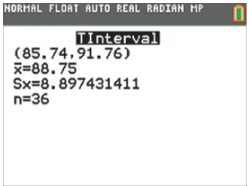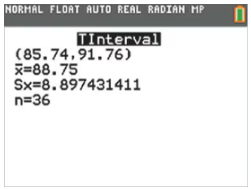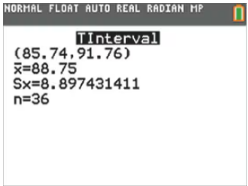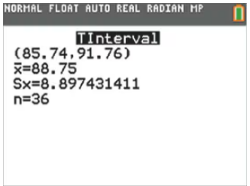 Back
BackProblem 1a
In Exercises 1–4, refer to the accompanying screen display that results from a simple random sample of times (minutes) between eruptions of the Old Faithful geyser. The confidence level of 95% was used.
Refer to the accompanying screen display.
a. Express the confidence interval in the format that uses the “less than” symbol. Round the confidence interval limits given that the original times are all rounded to one decimal place.
Problem 2a
In Exercises 1–4, refer to the accompanying screen display that results from a simple random sample of times (minutes) between eruptions of the Old Faithful geyser. The confidence level of 95% was used.
Degrees of Freedom
a. What is the number of degrees of freedom that should be used for finding the critical value ta/2?
Problem 2b
In Exercises 1–4, refer to the accompanying screen display that results from a simple random sample of times (minutes) between eruptions of the Old Faithful geyser. The confidence level of 95% was used.
Degrees of Freedom
b. Find the critical value ta/2 corresponding to a 95% confidence level.
Problem 3
In Exercises 1–4, refer to the accompanying screen display that results from a simple random sample of times (minutes) between eruptions of the Old Faithful geyser. The confidence level of 95% was used.
Interpreting a Confidence Interval The results in the screen display are based on a 95% confidence level. Write a statement that correctly interprets the confidence interval.
Problem 5
In Exercises 5–8, (a) identify the critical value ta/2 used for finding the margin of error, (b) find the margin of error, (c) find the confidence interval estimate of u, and (d) write a brief statement that interprets the confidence interval.
Birth Weights Here are summary statistics for randomly selected weights of newborn girls: n=36, x=3150.0g, s=695.5g (based on Data Set 6 “Births” in Appendix B). Use a confidence level of 95%.
Problem 7.C.3
Cell Phone Radiation. Listed below are amounts of cell phone radiation (W/kg) measured from randomly selected cell phones (based on data from the Federal Communications Commission). Use these values for Exercises 1–6.
[Image]
Level of Measurement What is the level of measurement of these data (nominal, ordinal, interval, ratio)? Are the original unrounded amounts of radiation continuous data or discrete data?
Problem 7.r.9a
Alcohol in Children’s Movies Listed below is a simple random sample of times (seconds) that animated children’s movies showed the use of alcohol (based on Data Set 20 “Alcohol and Tobacco in Movies” in Appendix B).
a. Are the requirements for constructing a 95% confidence interval estimate of the population mean satisfied? If so, construct that confidence interval.
Problem 7.c.10a
Tour de France Listed below are the average speeds (km/h) of winners of the Tour de France men’s bicycle race. The speeds are listed in order by year, beginning with the year 2000.
a. Construct a 95% confidence interval estimate of the population mean.
Problem 7.CQQ.7
Requirements A construction quality control analyst has collected a random sample of six concrete road barriers, and she plans to weigh each of them and construct a 95% confidence interval estimate of the mean weight of all such barriers. What requirements must be satisfied in order to construct the confidence interval with the method from Section 7-2 that uses the t distribution?
Problem 7.CQQ.8
Degrees of Freedom In general, what does “degrees of freedom” refer to? For the sample data described in Exercise 7 “Requirements,” find the number of degrees of freedom, assuming that you want to construct a confidence interval estimate of u using the t distribution.
Problem 7.RE.4
Space Mountain Use the following wait times (minutes) for the Space Mountain ride at Disney World (from Data Set 33 “Disney World Wait Times” in Appendix B). Construct a 95% confidence interval estimate of the mean of all wait times. Write a brief statement that interprets that confidence interval.
40 35 40 40 25 80 50 30 35 40
Problem 7.RE.5a
Distributions Identify the distribution (normal, Student t, chi-square) that should be used in each of the following situations. If none of the three distributions can be used, what other method could be used?
a. In constructing a confidence interval of , you have 75 sample values and they appear to be from a population with a skewed distribution. The population standard deviation is not known.
Problem 7.RE.10b
Arm Circumferences Listed below are arm circumferences (cm) of randomly selected women (based on Data Set 1 “Body Data” from Appendix B). Also shown is the normal quantile plot of those measurements.
b. Are the requirements for constructing a 95% confidence interval estimate of the population standard deviation satisfied? If so, construct that confidence interval.
Problem 7.CR.8b
Controversial Song The song “Baby It’s Cold Outside” generated much controversy because of its lyrics and tone. CBS New York conducted a survey by asking viewers to use the Internet to respond to a question asking whether that song was really too offensive to play. Among 1043 Internet users who chose to respond, 986 said that the song was not too offensive, and 57 of the respondents said that the song was too offensive.
b. Based on the result from part (a), is it safe to say that the majority of the population does not feel that the song is too offensive.
Problem 7.CR.8c
Controversial Song The song “Baby It’s Cold Outside” generated much controversy because of its lyrics and tone. CBS New York conducted a survey by asking viewers to use the Internet to respond to a question asking whether that song was really too offensive to play. Among 1043 Internet users who chose to respond, 986 said that the song was not too offensive, and 57 of the respondents said that the song was too offensive.
.
c. What is wrong with this survey? Based on this survey, what do we really know about the population?
Problem 7.r.1a
Bachelor’s Degree in Four Years In a study of government financial aid for college students, it becomes necessary to estimate the percentage of full-time college students who earn a bachelor’s degree in four years or less. Find the sample size needed to estimate that percentage. Use a 0.1 margin of error, and use a confidence level of 95%.
a. Assume that nothing is known about the percentage to be estimated.
Problem 7.r.1b
Bachelor’s Degree in Four Years In a study of government financial aid for college students, it becomes necessary to estimate the percentage of full-time college students who earn a bachelor’s degree in four years or less. Find the sample size needed to estimate that percentage. Use a 0.1 margin of error, and use a confidence level of 95%.
b. Assume that prior studies have shown that about 40% of full-time students earn bachelor’s degrees in four years or less.
Problem 7.r.2
Bachelor’s Degree The president of Brown University wants to estimate the mean time (years) it takes students to earn a bachelor’s degree. How many students must be surveyed in order to be 95% confident that the estimate is within 0.2 year of the true population mean? Assume that the population standard deviation is sigma=1.3 years
Problem 7.1.21a
Critical Thinking. In Exercises 17–28, use the data and confidence level to construct a confidence interval estimate of p, then address the given question.
Touch Therapy When she was 9 years of age, Emily Rosa did a science fair experiment in which she tested professional touch therapists to see if they could sense her energy field. She flipped a coin to select either her right hand or her left hand, and then she asked the therapists to identify the selected hand by placing their hand just under Emily’s hand without seeing it and without touching it. Among 280 trials, the touch therapists were correct 123 times (based on data in “A Close Look at Therapeutic Touch,” Journal of the American Medical Association, Vol. 279, No. 13).
a. Given that Emily used a coin toss to select either her right hand or her left hand, what proportion of correct responses would be expected if the touch therapists made random guesses?
Problem 7.1.13
Constructing and Interpreting Confidence Intervals. In Exercises 13–16, use the given sample data and confidence level. In each case, (a) find the best point estimate of the population proportion p; (b) identify the value of the margin of error E; (c) construct the confidence interval; (d) write a statement that correctly interprets the confidence interval.
Tennis Challenges In a recent U.S. Open tennis tournament, men playing singles matches used challenges on 240 calls made by the line judges. Among those challenges, 88 were found to be successful with the call overturned. Construct a 95% confidence interval for the proportion of successful challenges.
Problem 7.1.9
Formats of Confidence Intervals. In Exercises 9–12, express the confidence interval using the indicated format. (The confidence intervals are based on the proportions of red, orange, yellow, and blue M&Ms in Data Set 38 “Candies” in Appendix B.)
Green M&Ms Express 0.116 < p < 0.192 in the form of p +-E.
Problem 7.1.22
"Critical Thinking. In Exercises 17–28, use the data and confidence level to construct a confidence interval estimate of p, then address the given question.
Internet Use A random sample of 5005 adults in the United States includes 751 who do not use the Internet (based on three Pew Research Center polls). Construct a 95% confidence interval estimate of the percentage of U.S. adults who do not use the Internet. Based on the result, does it appear that the percentage of U.S. adults who do not use the Internet is different from 48%, which was the percentage in the year 2000?"
Problem 7.1.19a
Critical Thinking. In Exercises 17–28, use the data and confidence level to construct a confidence interval estimate of p, then address the given question.
Tennis Challenges In a recent U. S. Open tennis tournament, women playing singles matches used challenges on 137 calls made by the line judges. Among those challenges, 33 were found to be successful with the call overturned.
a. Construct a 99% confidence interval for the percentage of successful challenges.
Problem 7.1.19b
Critical Thinking. In Exercises 17–28, use the data and confidence level to construct a confidence interval estimate of p, then address the given question.
Tennis Challenges In a recent U. S. Open tennis tournament, women playing singles matches used challenges on 137 calls made by the line judges. Among those challenges, 33 were found to be successful with the call overturned.
b. Compare the result from part (a) to this 99% confidence interval for the percentage of successful challenges made by the men playing singles matches: . Does it appear that either gender is more successful than the other?
Problem 7.1.20b
Critical Thinking. In Exercises 17–28, use the data and confidence level to construct a confidence interval estimate of p, then address the given question.
OxyContin The drug OxyContin (oxycodone) is used to treat pain, but it is dangerous because it is addictive and can be lethal. In clinical trials, 227 subjects were treated with OxyContin and 52 of them developed nausea (based on data from Purdue Pharma L.P.).
b. Compare the result from part (a) to this 95% confidence interval for 5 subjects who developed nausea among the 45 subjects given a placebo instead of OxyContin: . What do you conclude?
Problem 7.1.4
Confidence Levels
Given specific sample data, such as the data given in Exercise 1, which confidence interval is wider: the 95% confidence interval or the 80% confidence interval? Why is it wider?
Problem 7.1.5
Finding Critical Values.
In Exercises 5–8, find the critical value z=a/2 that corresponds to the given confidence level.
90%
Problem 7.1.7
Finding Critical Values
In Exercises 5–8, find the critical value z=a/2 that corresponds to the given confidence level.
99.5%
Problem 7.1.14
Constructing and Interpreting Confidence Intervals. In Exercises 13–16, use the given sample data and confidence level. In each case, (a) find the best point estimate of the population proportion p; (b) identify the value of the margin of error E; (c) construct the confidence interval; (d) write a statement that correctly interprets the confidence interval.
Eliquis The drug Eliquis (apixaban) is used to help prevent blood clots in certain patients. In clinical trials, among 5924 patients treated with Eliquis, 153 developed the adverse reaction of nausea (based on data from Bristol-Myers Squibb Co.). Construct a 99% confidence interval for the proportion of adverse reactions.
Problem 7.1.16
Constructing and Interpreting Confidence Intervals. In Exercises 13–16, use the given sample data and confidence level. In each case, (a) find the best point estimate of the population proportion p; (b) identify the value of the margin of error E; (c) construct the confidence interval; (d) write a statement that correctly interprets the confidence interval.
Medical Malpractice In a study of 1228 randomly selected medical malpractice lawsuits, it was found that 856 of them were dropped or dismissed (based on data from the Physicians Insurers Association of America). Construct a 95% confidence interval for the proportion of medical malpractice lawsuits that are dropped or dismissed.





